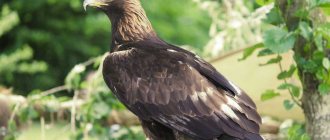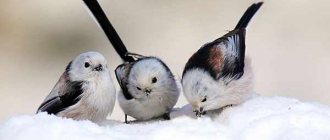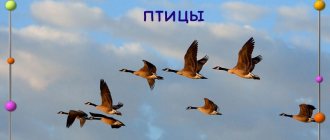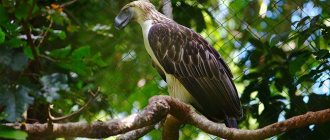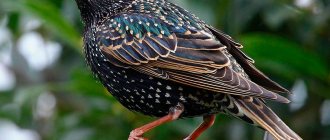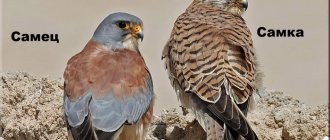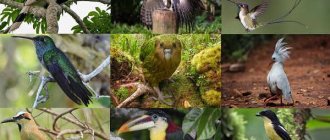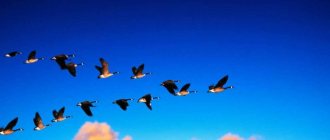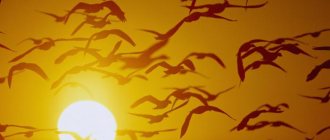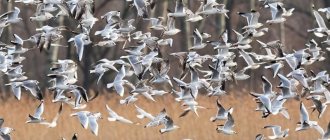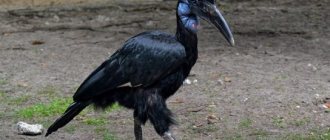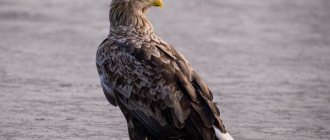Wonderful pictures with migratory and wintering birds. Which birds remain to spend the winter in their homeland, and which ones fly away?
Walking through a park or forest, we listen to birds singing and often simply don’t think about which bird trills so nicely. There are birds that live in our area all year round, but there are also those that fly to “warmer climes” in the fall.
Wild ducks in the sky
The fact is that in winter it is very difficult for birds to find food for themselves, because insects, berries and grains become scarce, and when snow falls, it is almost impossible to find them at all. And different species of birds solve this problem in different ways: migratory birds fly hundreds and even thousands of kilometers to warmer countries, while sedentary birds adapt to our harsh winters.
A tit in the snow, which apparently wants to eat some seeds
Settled, wintering birds: list, photos with names
To help the birds that remain over the winter find food, feeders are hung. And it is quite possible that they will be of interest to the following visitors:
- Sparrow . Noisy sparrows that fly in flocks may well become the first visitors to the feeder.
flock of sparrows
- Tit. Tits are in many ways not inferior to sparrows; they quickly rush to feed in feeders. But compared to sparrows, tits are endowed with a more gentle disposition. Interestingly, in the summer the tit eats almost as much food as it weighs. You can often see mixed flocks of both sparrows and tits at feeders.
Tit with a piece of bread
Sparrows and tit
- Gaichka . A close relative of the tit. However, the chickadee's breast is not yellow, but light brown. The chickadee also differs from other tits in that it makes a hollow in a tree to make a nest in it.
The chickadee is a special type of tit
- Crow. Ravens are often confused with rooks. It is known that in the western part of Russia crows are very rare. Therefore, if you live in the European part of Russia and see a black bird emitting a piercing croak, then most likely it is a rook.
Black Crow
- Pigeon. The distribution and lifestyle of pigeons was largely influenced by people who simply brought them with them to different parts of the Earth. Now pigeons are found on all continents except Antarctica. Pigeons easily exchange rocks, which are their natural habitat, for man-made structures.
The nodding gait of pigeons is due to the fact that this makes it easier for them to examine the object of interest to them.
- Woodpecker. In the warm season, woodpeckers feed mainly on insects, which they get from under the bark of trees, and in the cold winter, they can also feed on plant foods: seeds and nuts.
Woodpeckers love to eat seeds from pine and spruce cones.
- Magpie. The magpie is considered a bird of high intelligence; it is capable of expressing a lot of emotions, including sadness, and can recognize its reflection in the mirror. It is interesting that not only its fellow birds react to the alarming cry of a magpie, but also other birds, as well as wild animals, in particular bears and wolves.
Magpie - wintering bird
- Owl . Owls come in different varieties, large and small, and there are more than 200 species in total. These birds are endowed with acute vision and excellent hearing, which allows them to lead a nocturnal lifestyle. It is interesting that the tufts on the owl's head are not ears, the real ears of owls are hidden in the feathers, and one of them is directed upward, and the other downwards, in order to better hear what is happening above the head and on the ground.
Owl is a night bird
- Owl. This bird is also considered an owl and is a close relative of other owls.
Owl
- Tawny owl. A rare owl that lives mainly in mountainous areas in northern latitudes. The name of the bird, according to different versions, means “inedible” or “insatiable.”
Tawny Owl
- Jackdaw. Externally, jackdaws are similar to rooks and crows; moreover, there are mixed flocks in which all three species of birds can be seen. However, the jackdaw is smaller in size than the crow. And if you are lucky enough to observe a jackdaw up close, you can easily recognize it by the gray color of some of its feathers.
Jackdaws really like shiny objects
- Nuthatch. This little bird climbs tree trunks very deftly. In summer, nuthatches hide seeds and nuts in the bark, and in winter they feed on these supplies.
Nuthatch on a birch tree
- Crossbill. Like the nuthatch, this bird is excellent at climbing trees and can hang upside down on branches. Crossbill's favorite food is seeds from spruce and pine cones. This bird is remarkable in that it can hatch chicks even in winter, but only if there is enough food.
Crossbill on spruce branches
- Bullfinch. Only males have bright red plumage on the chest; females look much more modest. Bullfinches are more often seen in winter, because due to lack of food, they are drawn to people. In summer, bullfinches prefer wooded areas and behave inconspicuously, so they are not easy to see.
Pair of bullfinches
- Waxwing . A bird with beautiful plumage and a singing voice. In summer it feeds mainly on insects and likes to settle in coniferous forests. In winter, the waxwing moves to more southern regions of the country and is often found in cities. In the cold season, rowan and other fruits become the main food for birds.
Waxwing on a rowan branch in winter
- Jay. A large bird, which, however, can fly to feast on a feeder hung by people. In the summer it is rarely seen in the city, but closer to winter the bird begins to reach out to human habitation.
Jay in winter
- Kinglet. One of the smallest birds, the weight of an adult male is only 5-7 grams. Kinglets are relatives of sparrows.
Kinglet - forest dweller
- Pheasant . A large bird that is a favorite trophy for many hunters. Pheasants can fly, but most often move on foot.
Pheasant
- Hazel grouse . It is also an object of hunting, despite the fact that this bird is quite small. The weight of an adult hazel grouse rarely reaches 500 g. Interestingly, the largest population of these birds lives in Russia.
The hazel grouse is a bird that is related to the black grouse
- Black grouse. Another bird that is related to hunting. Black grouse are found at the edge of the forest and in the forest-steppe.
Grouse
- Sokol . It is considered one of the smartest birds on the planet and one of the best hunters. The falcon is capable of working in tandem with a person, but it is very difficult to tame it.
Falcon in flight
- Hawk . Like the falcon, it is a bird of prey. A hawk's vision is 8 times sharper than a human's. And rushing after prey, the hawk can reach speeds of up to 240 km/h.
Hawk
Jay
Belongs to passerines. The bird reaches 34 centimeters in length and weighs approximately 180 grams. The bird feeds on seeds of spruce, sunflowers, and cereal grains. In warm regions, jays' favorite food is acorns. The birds not only eat them on the spot, but also bury them in the ground as reserves. The jay is famous for its ability to imitate the voices of other animals and various sounds. The bird easily reproduces the creaking of a door, the barking of dogs, and the trill of a nightingale.
Listen to the voice of the jay
It is easier to hear a jay than to see it. Feathered carefully. If you are lucky enough, you see an elegant bird with white and blue flashes on its wings and a small crest on its head. In addition to plant food, the jay accepts game and can eat the eggs of other birds or already hatched chicks.
Migratory and nomadic birds: list, photos with names
- Rook. Rooks differ from crows in having a gray-yellow beak. In Kuban and Ukraine, you can see how in the fall rooks gather in huge flocks, so large that the sky seems black from the birds soaring in it - these are rooks that fly south. However, rooks are classified as migratory birds only conditionally, some of them remain to winter in central Russia, some winter in Ukraine, and only some birds fly to the warm shores of Turkey for the winter.
The sky in which rooks circle
- Rooks love to fly to freshly dug ground; sometimes they fly right behind a plowing tractor in order to have time to get as many worms and larvae as possible from the dug up ground.
Rook
- Nightingale. This inconspicuous bird with a singing voice loves warmth, and therefore flies south in the fall. And for wintering, our native nightingales chose hot Africa. These birds fly to the eastern part of the continent - Kenya and Ethiopia - for the winter. However, local residents cannot enjoy their singing, because nightingales sing only during the mating season, which takes place in their homeland.
Nightingale
- Martin. Swallows love rocky terrain; they often settle on the steep walls of quarries that people have dug. However, our winters are too harsh for swallows and therefore in the fall they fly to the southern part of Africa, far from us, or to Tropical Asia.
Swallow in flight
- Chizh . Like the rook, it is a migratory bird that arrives early and winters nearby: in the Caucasus, Kazakhstan and southern Europe. Externally, siskins are inconspicuous, their gray-green feathers are absolutely not noticeable against the background of the branches. The bird's temperament matches its appearance: quiet and meek.
Gray-green plumage of a siskin
- Goldfinch. In Europe it is a wintering bird, however, in Russia goldfinches can only be seen in summer. By winter, goldfinches gather in flocks and move to lands with a warmer climate. Goldfinches are close relatives of siskins.
The goldfinch is one of the most colorful birds
- Wagtail. A slender bird that runs quickly along the ground and shakes its tail with every step. Wagtails spend the winter in eastern Africa, southern Asia, and sometimes southern Europe.
Wagtail
- Quail. The only bird from the Galliformes order that is migratory. The weight of an adult quail is not so large and amounts to 80-150 g. In summer, quails can be found in fields sown with wheat and rye. Quails winter far beyond the borders of our homeland: in southern Africa and southern Asia, on the Hindustan Peninsula.
Quail in the grass
- Drozd . The song thrush, with its sweet trills, creates worthy competition for the nightingale. And his appearance, like that of the nightingale, is inconspicuous. In winter, blackbirds become Europeans: Italy, France and Spain are their second homeland.
song thrush
- Lark . Larks return from warm countries very early; sometimes already in March you can hear their sonorous song, which becomes a harbinger of spring warmth. And larks spend the winter in Southern Europe.
Lark in spring
- Seagull . With the onset of cold weather, seagulls living on the coasts of the northern seas migrate to the Black and Caspian Seas. But over the years, seagulls are increasingly drawn to people, and increasingly remain to spend the winter in cities.
Seagull on the warm coast
- Swift . Swifts winter in Africa, and fly to its equatorial part or even go to the southern part of the continent.
Swift
- Starling. Starlings really need birdhouses, since most often they breed their offspring in them. And our starlings go to Southern Europe and East Africa for the winter.
Starling This bizarre black cloud is a flock of starlings returning home
- Chaffinch . Finches from the western part of the country winter mainly in Central Europe and the Mediterranean, and finches that live near the Urals in the summer go to winter in Southern Kazakhstan and the southern regions of Asia.
Chaffinch - a noisy inhabitant of the forest
- Heron . It is quite difficult to determine where herons spend the winter; some of them travel huge distances to South Africa, some winter in the Crimea or the Kuban, and in the Stavropol Territory, herons sometimes even remain for the winter.
Heron in a pond
- Crane . These birds are monogamous, and once having chosen a partner, they remain faithful to him throughout their lives. Cranes settle in swampy areas. And their wintering places are as diverse as those of herons: Southern Europe, Africa and even China - in all these parts of the world you can find cranes that have flown from Russia to spend the winter.
Cranes
- Stork . In Russia there are black and white storks. White storks build huge nests, up to one and a half meters wide, and make very long flights to the south. Sometimes they cross half the planet and reach South Africa, a country located in the very south of Africa.
Storks nest
- Swan . The swan is a bird that represents devotion and romance. Swans are waterfowl, so for wintering they choose places near water, often the Caspian or Mediterranean Sea.
Swan mother and her babies
- Duck . Wild ducks, as a rule, do not fly far in winter and remain in the vast expanses of post-Soviet states. It is noteworthy that their domestic relatives also begin to worry in the fall and sometimes try to fly away, sometimes they even fly over fences and fly short distances.
wild ducks
- Cuckoo . Cuckoos live in forests, forest-steppe, and steppe. The vast majority of cuckoos fly to tropical and South Africa for the winter; less commonly, cuckoos winter in South Asia: India and China.
Cuckoo
- Oriole . A small bird with a singing voice and bright plumage that flies to the tropics for the winter.
Oriole
- Robin . They wake up at dawn and are among the first to start the morning song. This little songbird used to be called a robin. Robins fly to Southern Europe, North Africa and the Middle East to spend the winter and are among the first to return home.
Robin
Water
Birds that prefer an aquatic habitat can be divided into river and sea birds. Their species diversity is quite large. However, these individuals are united by a love of swimming and dietary features: fish, small sea and river animals, and mollusks.
Waterfowl
River
The territory of Russia is rich in large and small rivers and lakes. Therefore, there are all the necessary conditions for the existence of river bird species. Valleys near reservoirs simultaneously serve as places for them to feed, nest, molt, rest, etc.
Kabansky reserve (Baikal)
Turpan
Belongs to the Anseriformes family. The length of the scoter reaches about 55 cm on average. Weight – a little more than 1 kg. The male and female are slightly different in size and color: males are black and females are brown. They feed on small river fish and shellfish. Turpan is an endangered species.
Turpan Interesting fact: scoters are able to dive 10 m deep into a body of water in search of food, and also spend about a minute under water.
Kingfisher
Kingfishers are no larger than sparrows, but are distinguished by their extremely bright colors and long beaks. They have a blue back and a reddish belly, and white feathers on the sides of their heads. For nesting, kingfishers dig holes on river cliffs. Sometimes, in search of food, a bird can fly at high speed just above the surface of the water.
Kingfisher
Sailor
Other names for the bird are alley, sauk. Belongs to Anseriformes. A characteristic feature of long-tailed ducks is a long, thin tail, characteristic of males. Both males and females regularly change color depending on the mating season, age, and time of year. Sailors are capable of diving deeply - up to 60 m.
Sailor
Loon
There are three species of loons in the Russian Federation: black-throated, red-throated and arctic. Black-throated is the most common. Body length is about 60-75 cm. Males weigh from 2.4 to 3.4 kg, and females are smaller. Loons change color depending on age and season.
Black-throated Loon
Whooper swan
Large graceful birds are up to 1.8 m in length and weigh about 10 kg. They prefer to make huge nests on lakes and in reeds. Swans are known for forming pairs for many years. Whoopers make loud noises both while swimming and in flight. They feed on plants and aquatic invertebrates.
Whooper swan
Marine
Many aquatic birds of Russia are found on the shores of the Okhotsk, Bering and other seas. Bird markets are formed here. These zones serve as a haven for both permanent and migratory inhabitants.
Bird market, Sea of Okhotsk
Hatchet
The hatchet belongs to the order Charadriiformes. The bird's body is about 40 cm long, weight - on average 700 g. The color is predominantly dark - black, brown, with the exception of white cheeks, an orange beak, yellow paws and long bright feathers behind the eyes. Birds unite in large colonies. They fly, swim and dive very well.
Toporok Interesting fact: several geographical features are named after Toporok. For example, Toporkovy Island (Kuril Islands) and Toporkov Island (Commander Islands).
Storm petrel
In the Russian Federation, the family of storm petrels is represented by two species – black and gray, which have much in common. Storm petrels are small in size, but have long wings. Birds move very quickly and from a distance they can be confused with swallows. The diet of storm petrels consists of small fish and plankton.
Storm petrel
White-tailed eagle
A large bird of prey that weighs 5 kg on average, and the body grows to almost 1 m in length. The color is brown with lighter plumage on the chest. The name of the species comes from the white tip of the tail. It is noteworthy that females are larger than males. Eagles feed on fish, so they live near bodies of water. The nests are built large - 1 m in height and 2 m in length. Listed in the Red Books (RF and international).
White-tailed eagle Interesting fact: the wingspan of a white-tailed eagle is up to 2.5 meters.
Cormorant
Of the Cormorant family, the most common species in the country is the Bering cormorant. It is distinguished by its black color with a metallic sheen. Females are usually larger (body up to 77 cm in length and weight about 1.5 kg). Cormorants have at least 6 color changes, which depend on the mating season.
Bering cormorant
Guillemot
There are two types of guillemots: thin-billed and thick-billed, which are very similar in appearance. They are common on the shores of the Far Eastern seas. The basis of the diet is fish. Murres have a conservative character, which can be seen in monogamy and a permanent nesting site. Guillemots are more adept at swimming than at staying in the air.
Guillemot
What is the difference between migratory birds and wintering birds: presentation for preschoolers
Wintering and migratory birds: presentation for preschoolers
Slide 2
Slide 3: presentation of migratory birds
Slide 4
Slide 5 Slide 6
Slide 7
Slide 8: presentation of wintering birds
Slide 9
Slide 10
Slide 11 Slide 12
Why do migratory birds fly to warmer regions where they spend the winter, and why do they come back?
Winter is a harsh test for birds. And only those who can get food for themselves in harsh conditions remain to spend the winter.
Bullfinch getting seeds
What could be the ways for birds to survive in the cold season?
- Some birds store food for the winter in the summer. They hide plant seeds, nuts, acorns, caterpillars and larvae in grass and cracks in tree bark. Such birds include the nuthatch.
- Some birds are not afraid of people and live near residential buildings. In winter, they find food in feeders and garbage heaps.
- Some birds are predators and feed on rodents. There are birds of prey that can feed on hares, hunt fish, small birds and bats.
Rowan saves many birds from hunger in winter.
If a bird can find food for itself in winter, it means it does not need to go on a tedious and difficult flight to warmer climes in the fall.
Bullfinches peck bread crumbs in a feeder
It would seem that everything is simple, and the only reason for the seasonal migration of birds is the lack of food. But in reality there are more questions here than answers. For example, imagine that a wild duck, which is a migratory bird, is provided with an artificially heated pond and a sufficient amount of food. Will she stay for the winter? Of course not. She will be called on a long journey by a strong feeling that is difficult to explain, called natural instinct.
Wild ducks in the sky
It turns out that birds fly to warmer regions, as if out of habit, because their ancestors did this for hundreds and thousands of years.
Chicks
Another question that requires an answer: why do birds return from warm countries every spring? Ornithological scientists have concluded that the beginning of the return flight is associated with the activation of sex hormones and the beginning of the breeding season. But why do birds fly thousands of kilometers and hatch their chicks exactly where they were born? Poets and romantic people say that birds, like people, are simply drawn to their homeland.
How do migratory birds know where to fly? A question to which to this day there is no clear answer. It has been experimentally proven that birds can navigate in completely unfamiliar terrain and in conditions of limited visibility, when neither the sun nor the stars are visible. They have an organ that allows them to navigate the Earth's magnetic field.
But the mystery remains how young individuals, who have never flown to warm regions before, find their own wintering place, and how do they know the route to fly? It turns out that in birds, at the genetic level, information about the point on the map where you need to fly is recorded and, moreover, a route to it is drawn.
Birds unerringly find their way to their wintering grounds
Birds remaining for the winter
Not all birds are considered migratory. There is a group of sedentary birds. That is, they have adapted quite well to living in urban environments. They are accustomed to living close to people, and they often feed them. People build special feeders and pour food into them. Birds living in the forest and eating larvae and beetles that hide under tree bark, and the berries of wild shrubs, can easily survive the winter in cold weather. At this time they will be able to find food for themselves.
The well-known crows, tits, wood grouse, jays, and sparrows are usually classified as sedentary birds. Some of them can also find food in trash cans - landfills and in bins, that is, they do not hesitate to eat waste.
Crossbills are also considered sedentary bird species. He has adapted to the cold so much that he even manages to build nests and hatch chicks in winter.
Which birds are the first and last to arrive in spring?
The rooks are the first to arrive in the spring . These birds return to their homeland in early spring, when the first thawed patches in the snow appear. With their strong beaks, rooks dig out larvae in such thawed areas, which form the basis of their diet.
The last to arrive are the birds, which feed on flying insects. These are swallows, swifts, and orioles. The diet of these birds consists of:
- Komarov
- Much
- Moshek
- Horseflies
- Zhukov
- Cicadas
- Butterflies
Since the emergence of a large number of adult flying insects from larvae requires warm weather and about two weeks of time, the birds that feed on them fly to their homeland after the mass appearance of these insects.
Geese are preparing to fly to warmer climes
Crossbill
Crossbill
Crossbill
Crossbill
A small bird of gray-brown color. The breast is crimson in the male and greenish in the female. Its dimensions can reach up to 20 cm. Its peculiarity is the presence of a large beak. The structure is cross, facilitating the extraction of seeds from the cones of coniferous trees and climbing their trunks. Habitat:
- Europe;
- Asia;
- Africa (northwest);
- Philippines;
- Central and North America.
The bird can often be seen in spruce forests. Most rarely, she chooses mixed plantings for wintering. Completely ignores cedar.
Interesting: Raven
